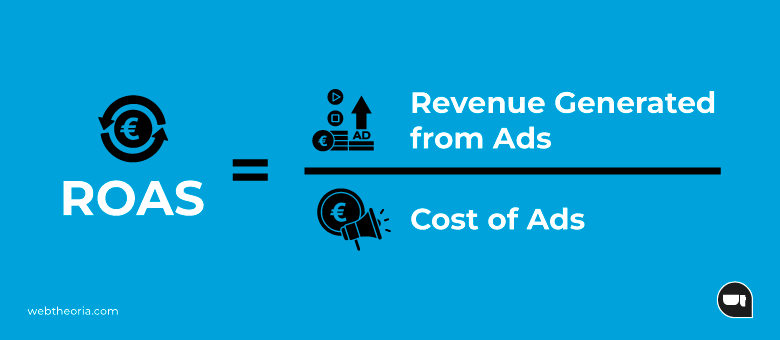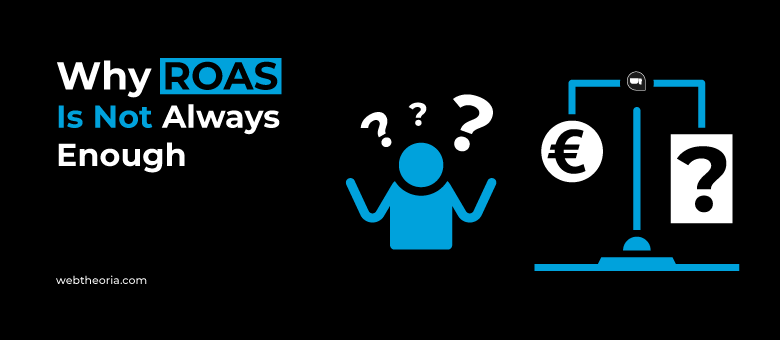At Web Theoria, we know that data-driven decision-making is the heart of every successful digital campaign. One of the most discussed metrics in online advertising is Return on Ad Spend, or ROAS. It’s a powerful figure that is often treated as the ultimate measure of success. But should it be?
The truth is more nuanced. While ROAS offers insight into the effectiveness of ad spend, it is not universally applicable across all industries or campaign types. And as an agency managing a wide range of client accounts, from e-commerce brands to service-based businesses, we have seen firsthand where ROAS works, and where it can be downright misleading.
Let’s unpack how to treat ROAS wisely, when to rely on it, and when it’s better to look beyond the numbers.
What Is ROAS and Why It’s Popular
ROAS, short for Return on Ad Spend, is a simple equation:
ROAS = Revenue Generated from Ads / Cost of Ads
If your campaign spends €500 and generates €2,500 in sales, the ROAS is 5. In other words, for every €1 spent, you earned €5.
Sounds great, right? That’s exactly why ROAS has become one of the go-to metrics for advertisers. It gives an immediate, digestible view of performance. However, that simplicity is also where its limitations begin.

When ROAS Deserves Your Attention
ROAS is most relevant in campaigns where conversions are direct, measurable, and happen quickly after a user sees or clicks an ad. For Web Theoria clients with online shops, course platforms, or lead generation campaigns, ROAS can be a valuable tool. With proper tracking infrastructure we can trace the full path from click to checkout.
In these situations, ROAS becomes a near real-time indicator of which campaigns, creatives, and audiences are generating the most revenue relative to ad spend. If we see strong ROAS trends, it allows for clear, confident scaling of budgets toward the highest-performing assets.
Why ROAS Isn’t Always Enough
However, ROAS should not be treated as a universal benchmark of success. In fact, we often advise clients to tread carefully when over-fixating on it.
For example, in service-based businesses like travel, healthcare, real estate, or legal services, the buying journey is rarely instant. A click may lead to a form submission or a phone call—not an immediate purchase. That’s where ROAS falls short. The ad platform doesn’t see what happens next, and valuable leads may be overlooked in the data.
Moreover, ROAS doesn’t account for operational costs, customer retention, or long-term value. A campaign might appear profitable on the surface but result in negative margins once shipping, fulfillment, or staffing are considered.
And finally, in brand awareness campaigns, where the goal is to build familiarity, not drive a sale, ROAS is not only irrelevant but potentially harmful if used to judge success. Killing off a brand campaign because it “didn’t convert” ignores the long-term value of visibility and engagement.
ROAS in Different Business Models
At Web Theoria, we adapt the way we measure success based on the client’s business model:
- E-commerce clients typically benefit from ROAS-focused strategies, especially when attribution is well-defined and the sales process is fully online.
- Service-based clients require a deeper view. For these accounts, we prioritize lead quality, engagement signals, and integration with CRMs to track what happens after someone clicks. ROAS alone can’t guide decisions in this context.
Complementary Metrics That Complete the Picture
At Web Theoria, we believe ROAS should never be evaluated in isolation. To get a clear and accurate understanding of campaign effectiveness, especially when managing diverse goals across different industries, we combine ROAS with other key performance indicators that better reflect actual business outcomes.
- Cost per Sale (CPS)
- Click-Through Rate (CTR)
- Cost per Click (CPC)
- Cost per Engagement (CPE)
- Conversion Rate
- Lead Quality (especially for high-ticket or service-driven industries)
- Reach
- Impressions
These metrics help provide a more accurate picture of both short-term and long-term success.
Best Practices from the Web Theoria Team
At Web Theoria, we don’t treat ROAS as the ultimate measure of success. Instead, we adapt our approach based on the client’s business model, campaign goals, and how much reliable data is available.
We begin by identifying the profit margins for each client so we can understand what ROAS is actually needed to make a campaign worthwhile. For e-commerce accounts, we set realistic ROAS goals that reflect net profit, not just revenue. When managing service-based campaigns, we connect advertising platforms like Google Ads and Meta Ads with CRM systems whenever possible. This allows us to trace performance beyond the click, right through to actual customer revenue.
We also evaluate campaigns based on their intent. For example, brand awareness campaigns are measured differently from campaigns focused on conversions. Each one serves a different purpose and should be judged accordingly.
Most importantly, we help clients look at ROAS as one piece of a larger strategy. A campaign with average ROAS might still be valuable if it brings in customers who continue to spend over time. On the other hand, a campaign with very high ROAS might just be capturing easy wins, with little room to grow.
Our goal is always the same: to make sure every campaign delivers meaningful, long-term value. Not just impressive numbers on a dashboard.
Final Thoughts
ROAS is not a bad metric, but it’s only one metric. Used wisely and in the right context, it can help guide spend, optimize performance, and drive real growth. But used in isolation, it risks leading businesses down the wrong path.
At Web Theoria, we look beyond surface-level metrics. Our job isn’t just to manage ad budgets, but to understand your business, measure what matters, and help you grow sustainably. Whether ROAS plays a starring role or a supporting one depends on your goals, and we are here to help you figure that out.
Published on December 04, 2025

